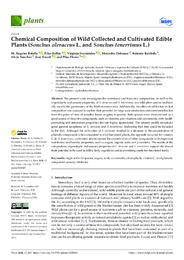Título :
Chemical Composition of Wild Collected and Cultivated Edible Plants (Sonchus oleraceus L. and Sonchus tenerrimus L.) |
Autor :
Botella, M. Ángeles 
Hellín, Pilar
Hernández, Virginia
Dabauza, Mercedes
Robledo, Antonio
Sánchez, Alicia
Fenoll, José
Flores, Pilar |
Editor :
MDPI |
Departamento:
Departamentos de la UMH::Biología Aplicada |
Fecha de publicación:
2024-01-17 |
URI :
https://hdl.handle.net/11000/32442 |
Resumen :
The present work investigates the nutritional and bioactive composition, as well as the
organoleptic and sensory properties, of S. oleraceus and S. tenerrimus, two wild plant species traditionally
used in the gastronomy of the Mediterranean area. Additionally, the effect of cultivation on leaf
composition was assessed to explore their potential for large-scale production and commercialization
from the point of view of possible losses or gains in quality. Both species were characterized as a
good source of bioactive compounds, such as vitamins, pro-vitamins and carotenoids, with healthpromoting
and antioxidant properties that are highly appreciated. The sensory profile revealed a
good general acceptance of S. oleraceus and S. tenerrimus, indicating that they could be included
in the diet. Although the cultivation of S. oleraceus resulted in a decrease in the concentration of
phenolic compounds when compared to wild-harvested plants, the opposite occurred for vitamin
C. In S. tenerrimus, cultivation also increased the concentration of other compounds with important
nutritional and healthy properties, such as sugars, organic acids and β-carotene. The results of the
composition, organoleptic and sensory properties of S. oleraceus and S. tenerrimus support the idea of
their potential to be used as edible leafy vegetables and as promising assets for functional foods.
|
Palabras clave/Materias:
neglected wild species
sugars
acids
carotenoids
chlorophylls
vitamin C
total phenolic compound
sensory attributes |
Área de conocimiento :
CDU: Ciencias puras y naturales: Biología |
Tipo de documento :
info:eu-repo/semantics/article |
Derechos de acceso:
info:eu-repo/semantics/openAccess |
DOI :
https://doi.org/10.3390/plants13020269 |
Publicado en:
Plants 2024, 13, 269 |
Aparece en las colecciones:
Artículos - Biología Aplicada
|
 La licencia se describe como: Atribución-NonComercial-NoDerivada 4.0 Internacional.
La licencia se describe como: Atribución-NonComercial-NoDerivada 4.0 Internacional.
.png)
